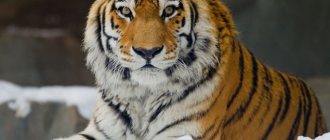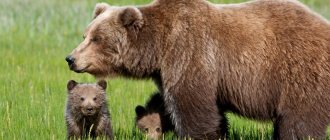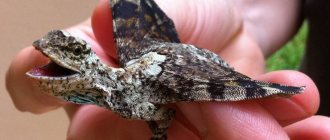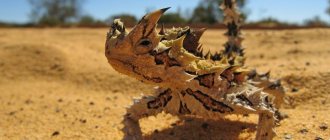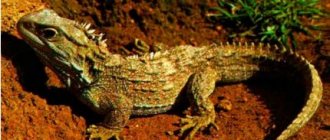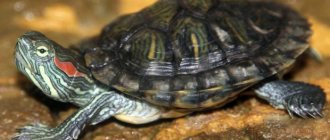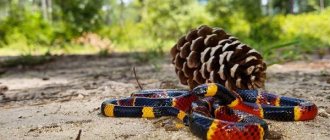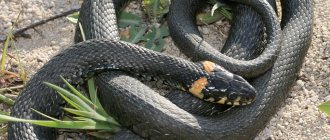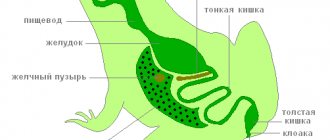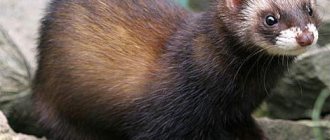XXI CENTURY Candy Fudge Scented water
266 ₽ More details
Video baby monitor Motorola MBP36S (white)
12900 ₽ More details
Light jacket for men
The descendants of extinct dinosaurs are numerous reptiles. The list of reptiles includes about ten thousand species. They all breathe through lungs, and their skin is covered with horny scales that protect it from drying out. There are 72 species of reptiles living in our country alone.
The list of reptiles includes about ten thousand species
What are reptiles?
Representatives of this class are cold-blooded creatures . Their body temperature is determined by the temperature of the environment. But they have one feature: they can regulate their temperature themselves. The ancestors of reptiles are amphibians. In winter, reptiles usually sleep. And in hot weather they are only nocturnal.
Reptiles have tough skin and are covered with scales . Such skin is needed to protect the body from drying out. These animals breathe only through their lungs. Some representatives of this class have lungs of the same size, while others have one lung larger than the other. And this is the norm. The skeleton of reptiles is well developed. Everyone has ribs, but their number depends on the representative of this class.
Almost all species of this class have a tongue , but some have a short tongue, while others have a very long one. It is also the main sense organ. To protect themselves from enemies, these animals change color, some have a hard shell, and some are even poisonous. These animals reproduce like birds, that is, they lay eggs.
The following animals belong to the class of reptiles:
- Snakes,
- Lizards,
- Turtles,
- Dinosaurs.
Class characteristics
The class of reptiles includes a certain group of cold-blooded animals and has a number of anatomical features. The limbs are located on both sides and widely spaced. During movement, the reptile's body drags along the ground, which does not prevent it from remaining fast and agile in times of danger or hunting.
In prehistoric times, this type of fauna lived in water. In the process of evolution, they switched to a terrestrial existence thanks to cellular lungs, dry body coverings and internal fertilization. During the growth process, the animal sheds periodically.
What they share with fish and amphibians is the body’s ability to regulate body temperature according to environmental conditions. In winter, they lose activity and hibernate. In southern latitudes with a hot climate, many of them are nocturnal. The dense horny cover and the absence of glands in the epidermis prevent moisture loss.
Distribution area
Reptiles are common on all continents except Antarctica. Their populations are especially numerous in tropical and subtropical regions.
The most viable species live on the territory of the Russian Federation. The list of names of reptiles that inhabit almost all regions of our country is quite extensive. It includes:
- Turtles - Far Eastern, Mediterranean, leatherback, Caspian, European marsh, loggerhead.
- Lizards - gray and Caspian gecko, motley and long-eared roundhead.
- Snakes - vipers, snakes, copperheads and yellowbellies.
Reptiles include lizards, snakes, and turtles.
All representatives of this class living in temperate climates are not large in size and prefer small areas for living, since they are incapable of long-distance migrations. They are characterized by high fertility. Females lay dozens of eggs. The population density on one hectare can reach one hundred and twenty individuals. Nutritional characteristics play an important role in the biological indication of nature.
Features of reproduction
Reptiles breed on the surface of land. Even those who spend most of their lives in water leave their usual habitat. The mating season is accompanied by increased activity and fights among males. This is especially common in lizards and turtles.
The main part of reptiles are oviparous reptiles. In some species, the egg remains in the oviduct until the baby is fully mature. Such animals belong to ovoviviparous representatives of the fauna.
Reptiles are naturally endowed with a high ability to survive and preserve the species
Types of reptiles
Reptiles or reptiles are divided into four orders:
- Turtles. There are about three hundred species.
- Crocodiles. There are twenty-five species.
- Hatteria or tuatara. The only representative of this order are beaked animals.
- Scaly. These include lizards and snakes. Their variety ranges around six thousand.
Reptiles can be found anywhere, but the largest number of them live in warm countries. Where it is always cold and there is little vegetation, these animals are very rare. Reptiles live everywhere . And in water, and on land, and in the air. Let's take a closer look at the representatives of this class.
Representatives of squamates - lizards and snakes
Lizards and snakes are scaly animals. They were named so because their body is covered with scutes and horny scales. Squamates are the most abundant among reptiles: there are approximately 6,000 species.
Both lizards and snakes have cylindrical bodies, but the vast majority of lizards have four limbs, a tail, and movable eyelids.
Structure of a snake's head
Amphisbaena, which today is considered a type of lizard, has a worm-like body that is covered with a solid horny film. The body is surrounded by narrow rings, the head is flat, and limbs are absent in most species.
The lizard has the ability to cast off its tail. This is one of the ways of defense: she sacrifices her tail to escape. After some time, her tail completely grows back. This phenomenon is called regeneration.
Snakes don't have legs. They also lack ear openings, eardrums and middle ears. Snakes pick up sound vibrations with their whole body directly from the ground, and their eyelids are motionless.
Everyone knows poisonous snakes, although they make up only a tenth of all species. Such a snake has modified salivary glands in its head behind its eyes, which produce strong poison. The snake's front teeth have a canal, or groove, through which the venom is introduced into the victim's body. What is sometimes called a stinger - a long forked tongue - has nothing to do with the poisonous apparatus. The ego is the organ of taste, smell and touch.
Snake venom is used in medicine to make medicines. In addition, snakes provide benefits by exterminating harmful rodents.
Snakes prefer to live in warm climates, although they are also found in temperate zones. They live everywhere - in steppes, forests, deserts, mountains. These are mainly terrestrial animals, although there are species that live underground, in trees and in water. The same way of life is characteristic of lizards. Amphisbaenas prefer to dig holes and very rarely appear on the surface.
Scaly animals, in particular lizards and snakes, have a habit of hibernating when unfavorable conditions occur.
Snakes and lizards usually lay eggs, although there are also viviparous species among them, which include some lizards and the common viper.
With the help of a long tongue, the chameleon, a representative of lizards, can catch prey at a distance greater than the length of its body
What to do if bitten by a snake?
If you are bitten by snakes, you should not self-medicate (make incisions, cauterizations, pressure bandages, etc.). The victim must be taken to a doctor as soon as possible. The most effective treatment is injection of a special anti-snake serum and blood transfusion. If you are bitten by a viper, it is recommended to drink hot tea or coffee.
Snake's look
The open eyes of snakes, it turns out, are always behind the eyelids, fused and transparent. They cover your eyes like a watch glass. Therefore, the snake's gaze is always motionless. This is where legends arose that the snake can supposedly hypnotize its prey. But this is not true at all. The predator's weapons are its speed, strength, mouth and poisonous teeth for those who have them.
Which snake is the biggest?
Anacondas are the largest snakes on Earth, close relatives of boas and pythons. They live only in South America and are found throughout the continent. Anacondas have a small head and a round, muscular body up to 10 m long. They weigh from 150 to 250 kg. They say that snakes 11 m long were encountered, but this could not be confirmed. Anacondas mainly feed on fish and small animals. Although the jaws of these snakes with sharp teeth have a special structure that allows them to swallow even adult crocodiles and deer.
How do snakes swallow prey?
All snakes swallow their prey whole. The jaw bones of these animals are connected by tensile ligaments and are mobile, and the teeth are curved back. The snake, as it were, pulls its head onto its prey, gradually swallowing it. Some snakes swallow their prey alive. Snakes that live near bodies of water or in the water also eat frogs and fish. Boas first strangle their prey by wrapping their body around it.
Turtles
Turtles are the most famous among reptiles. They can live both on land and in water. They can be seen not only in the zoo and in the wild; many people keep them at home. These cute animals do not pose any danger to humans; they are harmless.
Turtles appeared about two hundred million years ago. These reptiles have a shell. He protects them from enemies. It consists of two parts: abdominal and dorsal. On top it is covered with horny tissue in the form of plates.
These animals come in different sizes . There are giant turtles that can reach 900 kilograms. And there are little turtles. Their weight does not exceed 125 grams, and the length of the shell is only ten centimeters.
Instead of teeth, this animal has a powerful beak. She uses it to grind food.
Based on their habitat, turtles are divided into:
- Freshwater: painted or decorated, European marsh, red-eared, caiman,
- Marine: hawksbill, leatherback, green or soup turtle,
- Ground,
- Land animals: ivory, Egyptian, Central Asian, leopard, Cape,
What do these animals eat ? Their food depends entirely on their habitat. Land turtles feed on fruits, vegetables, tree branches, mushrooms and grass. And sometimes they can even eat worms and snails.
Aquatic turtles feed on small fish, shrimp, squid, frogs, snails, mollusks, insects, and bird eggs.
Land turtles that live at home eat cabbage, apples, tomatoes, beets, cucumbers, dandelions, and chicken eggs. And aquatic house turtles love to eat earthworms, boiled meat, bloodworms, insects, algae and lettuce.
The turtle is a long-liver. She will outlive any other representative of reptiles.
Ancient reptiles
It has been established that in the distant past (hundreds of millions of years ago) various types of reptiles were extremely common on Earth. They inhabited land, water, and, less commonly, air. Most species of reptiles became extinct due to climate change (cold temperatures) and the rise of birds and mammals, with which they could not compete. Extinct reptiles include orders of dinosaurs, wild-toothed lizards, ichthyosaurs, flying lizards, etc.
Dinosaur Squad
This is the most diverse and numerous group of reptiles that has ever lived on Earth. Among them were both small animals (the size of a cat and smaller) and giants, whose length reached almost 30 m and weight - 40-50 tons.
Large animals had a small head, a long neck and a powerful tail. Some dinosaurs were herbivores, others were carnivores. The skin either had no scales or was covered with a bone shell. Many dinosaurs ran hopping on their hind limbs, leaning on their tail, while others moved on all four legs.
Squad Animal-toothed
Among the ancient land reptiles there were representatives of a progressive group, which resembled animals in the structure of their teeth. Their teeth were differentiated into incisors, canines and molars. The evolution of these animals went in the direction of strengthening their limbs and belts. In the process of evolution, mammals arose from them.
Crocodiles
Crocodile
The crocodile is the only representative of the archosaur subclass. Their body length ranges from two to seven meters. And the mass can reach more than 700 kilograms. The crocodile is a fairly fast animal in the water. Its speed can reach forty kilometers per hour.
The number of teeth in a crocodile ranges from 70 to 100. This depends on the type of crocodile. The teeth are long and sharp, about five centimeters.
These animals live only in warm countries with a humid climate: Africa, Japan, Australia, Bali, North and South America, Guatemala, and the Philippine Islands.
The crocodile is a predator , so it eats fish, shellfish, birds, lizards, snakes, antelopes, deer, buffalos, wild boars, dolphins, sharks, leopards, lions, hyenas. These animals can even eat a monkey and a porcupine, a kangaroo and a bunny. And there are cases when crocodiles eat their own kind.
Crocodiles live for quite a long time - a hundred years.
Species of crocodiles
Crocodiles are divided into three families: true crocodiles, gharials and alligators.
In turn, crocodiles of the true family are divided into the following species:
- The combed one is the largest crocodile. Its length reaches two meters and it weighs about two tons.
- Tuporyly is the smallest crocodile. Its length does not exceed one and a half meters, and its weight does not exceed seventy kilograms.
- Nile - ranks second in size after the saltwater crocodile. Its length reaches five and a half meters, and it weighs about a ton.
- The Siamese is an endangered species of crocodile that is listed in the Red Book. Its body length reaches four meters, and its weight does not exceed 350 kilograms.
- Sharp-snout - differs from other species by its narrow, pointed snout.
- The Australian narrow-snout is distinguished not only by its narrow muzzle, but also by its small size. The length of its body does not exceed three meters.
The alligator family is divided into:
- Mississippian - differs from other species in that it can easily withstand the cold, freezing its entire body in the ice.
- Chinese is a rare and small species of alligator. Its length does not exceed two meters, and it weighs only about forty-five kilograms.
- Crocodile caiman - otherwise called the spectacled crocodile. This is due to the fact that on its face there are growths between the eyes that resemble glasses.
- The black caiman is a fairly large species of alligator. Its length reaches 5.5 meters and it weighs more than 500 kilograms.
The gharial family is divided into:
- Gangetic gharial. The length of his body reaches six meters, and he weighs only about two hundred kilograms.
- Gavial. The muzzle of this species is narrow and long. The body length is six meters, and the weight does not exceed 200 kilograms.
Crocodiles and alligators
Crocodiles and alligators are members of the crocodile genus. They have an elongated body with four limbs, covered with scales, or plates. Alligators are much smaller than their counterparts, their length rarely exceeds 5 m. In real crocodiles, the snout is relatively pointed, and the fourth lower tooth is visible from the outside in a special lateral recess of the upper jaw. Alligators have a wider snout, and the lower row of teeth is completely hidden behind the upper one.
The saltwater crocodile feels comfortable not only in river water, but also in sea water and even drives sharks away from coastal waters. The habitat of these crocodiles is quite extensive and is located in areas adjacent to the Indian and Pacific oceans
Crocodiles have a more advanced salt metabolism than alligators, so they can live in salt water, while alligators can only live in fresh water. Excess salts are removed from the crocodile's body with the help of special glands located on the tongue, as well as with the secretions of the lacrimal glands - the so-called crocodile tears.
Even the appearance of a crocodile dressed in a shell inspires fear. It has a huge mouth full of teeth, a powerful body and strong clawed paws. For people, these toothy monsters pose a particular danger. Often crocodiles snatch people right out of the boat.
Kaprosuchus is a prehistoric land crocodile. This animal with sharp teeth and a powerful jaw, reaching a length of 6.5 m, hunted small dinosaurs
The largest of the African crocodiles - the Nile - reaches 6 m in length and weighs up to 1 ton. He is called a cannibal, and in his native element he is very dangerous - he swims at speeds of up to 32 km/h, and on land he develops up to 15-18 km/h Therefore, it is better to avoid meeting him.
Unlike crocodiles, alligators are found only in fresh waters
Hatteria
Most people believe that the hatteria is a lizard. But this is a mistaken opinion. This reptile lived back in the era of dinosaurs and forms the order of beaked heads. This reptile has another name - tuatara.
They live only in New Zealand. In appearance they resemble an iguana. The internal structure is similar to that of a snake. They took some from turtles, and some from crocodiles.
She also has one more feature - three eyes . The third eye is located at the back of the head. The length of the hatteria reaches more than fifty centimeters, and it weighs no more than one kilogram.
This amazing animal is only nocturnal. The breathing of the hatteria is slow. She may not breathe for as long as sixty minutes.
This reptile feeds on insects, snails, and worms. Life expectancy is quite long, about a hundred years.
Lizards
Lizards belong to the class of reptiles . Their diversity is very large - about six thousand species. They all differ from each other in their size, color, and habitat.
Lizards are very similar to newts, but they have many differences. One of the main differences is that the newt is an amphibian. An amphibian is different from a reptile.
Almost all lizards have a feature - the ability to shed their tail in emergency situations. Many lizards can change body color.
Lizards feed on insects: butterflies, snails, grasshoppers, spiders, worms. Large representatives feed on small animals, snakes and frogs.
Lizards are divided into six infraorders:
- Skink-like,
- Iguanas,
- Gecko-shaped,
- Fusiform,
- Vermiformes,
- Monitor lizards
All these infraorders are divided into families. Skinkoids are divided into:
- Real,
- Gymnophthalmides,
- Night,
- Belttails,
- Gerrosaurs,
- Teyida,
- Skinks.
Iguanas are divided into fourteen families. The most striking representative of this infraorder is the chameleon.
Geckoformes are divided into seven families. Of which an unusual lizard can be distinguished is the scalepod. The peculiarity of this reptile is that it has no legs.
Fusiformes are divided into five families: earless monitor lizards, fusiformes, legless lizards, monitor lizards, xenosaurs.
Worm-like lizards consist of one family. These reptiles are similar to earthworms.
Monitor lizards consist of several families. They are the largest lizards. For example, a Komodo dragon can weigh more than ninety kilograms.
Description of individual species
Reptiles are naturally endowed with a high ability to survive and preserve the species. In the wild, both herbivores and predatory reptiles are found. The list of titles includes:
- turtles;
- crocodiles;
- lizards;
- snake.
There are about three hundred species of turtles. Distributed throughout the world. These harmless animals are often kept as pets. They are among the longest living reptiles. In favorable conditions they live up to two hundred and fifty years.
A strong shell protects them from predators, and their body weight and size depend on their belonging to a particular genus and habitat. Sea turtles can weigh about a ton and have impressive dimensions. Among land species there are tiny specimens weighing 125 grams and a shell length of 10 centimeters.
The animal's head is small, which makes it possible, in case of danger, to quickly remove it under the shell. The reptile has four limbs. The paws of land animals are adapted for digging soil; in marine animals they have turned into flippers.
Crocodiles are the most dangerous reptiles. The names of some species correspond to their habitat. The most famous of them:
- sea or rowing;
- Cuban;
- Mississippian;
- Philippine;
- Chinese;
- Paraguayan.
Crocodiles are divided into the families of gharials, caimans and alligators. They differ from each other in the shape of their jaws and body sizes.
Lizards are nimble representatives of the fauna. Most of them are small in size and have high regenerative ability. They inhabit different parts of the planet and are well adapted to different climatic latitudes.
The main part of lizards are small in size and have high regenerative ability.
The largest representative of the genus of lizards is the Komodo dragon . Named after the island of the same name on which it lives. Outwardly it resembles a cross between a dragon and a crocodile. They create a deceptive impression with their clumsiness. However, they are excellent runners and swimmers.
Snakes are included in the list of reptile animals that are missing limbs. Due to the elongated shape of the body, the internal organs acquired an identical structure. More than three hundred pairs of ribs located throughout the body help make flexible movements. The triangular head allows the snake to swallow its prey whole.
There are a huge number of different snakes in nature. Most of them are poisonous. The poison can kill some within a few minutes. Scientists have long learned to use snake venom as medicine and antidotes.
Snakes that lack venomous glands include grass snakes and pythons. The largest snake in the world lives on the banks of the Amazon and is called the anaconda. Kills the victim with the help of powerful muscles, wrapping it in rings.
https://youtube.com/watch?v=EFtHInEU4Jg
Due to water pressure, sea snakes lack a rounded shape and resemble a wriggling ribbon. They are very dangerous for humans, as they produce highly toxic poison. Once on land, they die within a few hours. They settle at the mouths of rivers flowing into the sea. They rarely swim far from the shore.
Difference from amphibians
Compared to amphibians, reptiles are better adapted to living on land. Their muscles are well differentiated. This explains their ability to make fast and varied movements.
The digestive system is longer. The jaws are equipped with sharp teeth that help chew even the toughest food. The blood supply is mixed, in which arterial blood predominates. Therefore, they have a higher metabolic rate.
Compared to amphibians, reptiles are better adapted to living on land
The size of the brain relative to the body is larger than that of amphibians. Behavioral characteristics and sensory organs are perfectly adapted to life on the surface of the earth.
Unique reptiles
Among the most interesting and rare reptiles there are those that have anatomical features that are unlike other species. The most remarkable representative of the unique fauna is Hatteria . It lives in only one place - New Zealand. Despite its external resemblance to a lizard, it does not belong to the genus of these reptiles. The internal organs are similar to those of a snake.
Despite its external resemblance to a lizard, tuateria does not belong to the genus of these reptiles
Unlike other animals, it has three eyes, with an additional organ of vision located in the back of the head. Possessing slow breathing, she is capable of not breathing for a minute. The body length is half a meter, weight is about one kilogram.
This is a nocturnal predator. It feeds mainly on small animals, crawling and flying insects. The maximum life expectancy is 100 years.
The unique features of reptiles are of interest to biologists and lovers of these animals. Some species have not been fully studied due to their secretive lifestyle and remote habitats. Even the most dangerous predators to humans contribute to the ecological balance of the planet and need protection from extermination.
